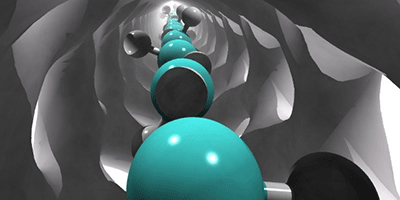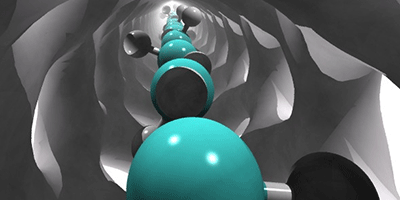Stop-and-Go Traffic through Nanotubes
Water molecules have only a single lane for traversing through narrow channels such as carbon nanotubes. The common assumption has been that molecules move in a constant stream through the channel, but new computer simulations show that molecules advance intermittently, like cars shuffling forward in stop and go traffic. The researchers, writing in Physical Review Letters, describe the overall motion along the water column in terms of solitary waves called solitons.
Nanochannels are common in biology, as they regulate fluid flow across cell membranes. They also have promising industrial applications for purifying and desalinating water. The walls of these tubes are so close that normally only a single file of molecules can fit inside. Naively one might suspect that adhesion to the walls would prevent movement through the channels, but surprisingly high flow rates of around 10 billion molecules per second are observed.
Previous molecular dynamics simulations showed that water molecules in a carbon nanotube are evenly spaced and that they move in lockstep with each other. However, Thomas Sisan and Seth Lichter of Northwestern University, Illinois, have performed new simulations with greater time resolution, revealing localized variations in the distribution of water along the tube, known as “solitons.” A soliton is a single-peak wave that maintains its shape as it travels. When a soliton passes through a particular section of the tube, the water molecules surge forward (like cars moving into a brief opening in traffic). The researchers show that mass transport by fast-moving solitons explains observed nanochannel flows. – Michael Schirber





